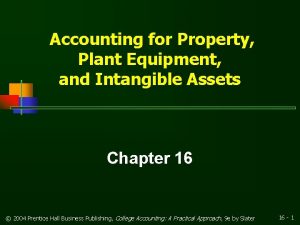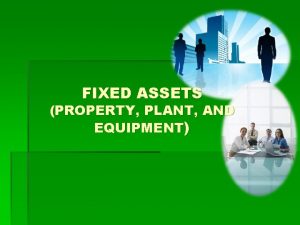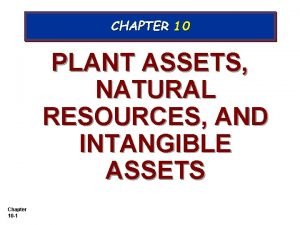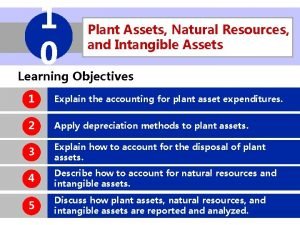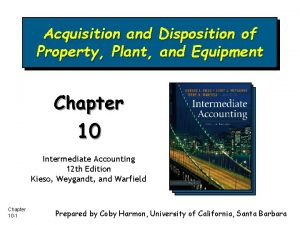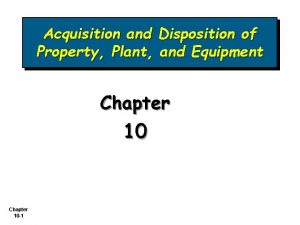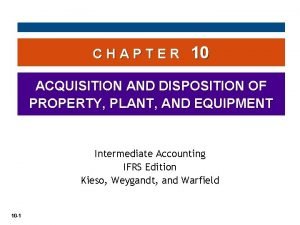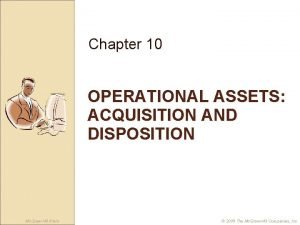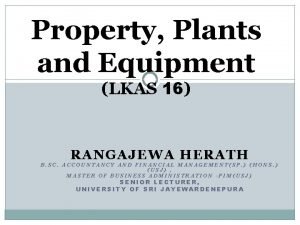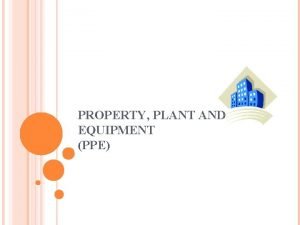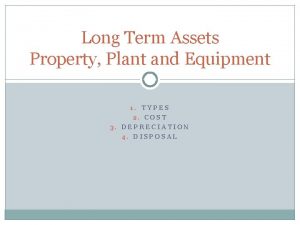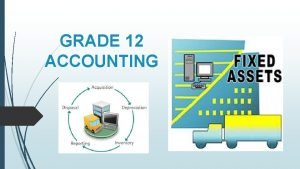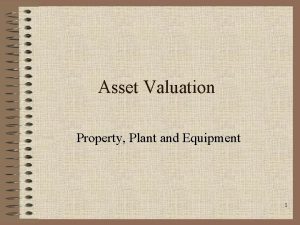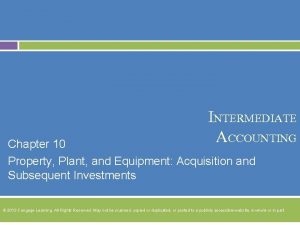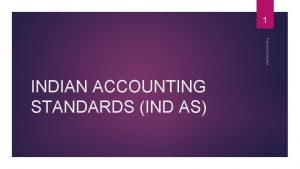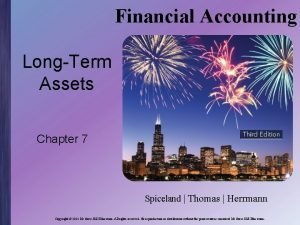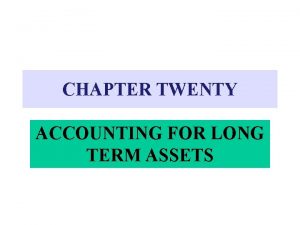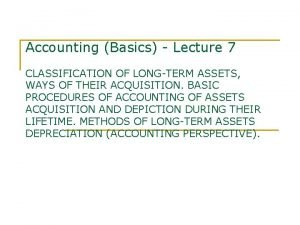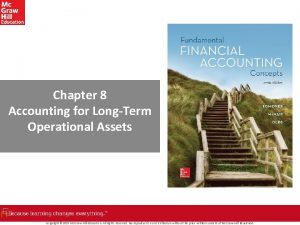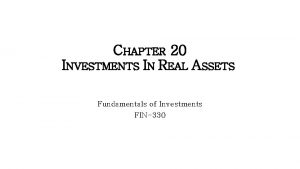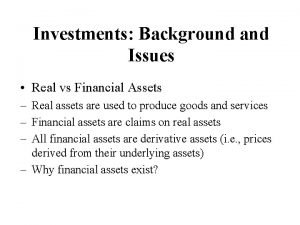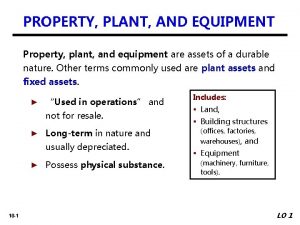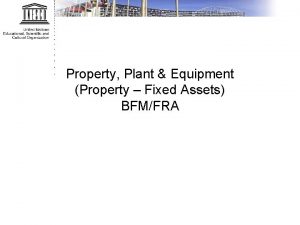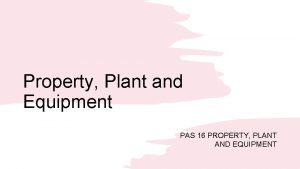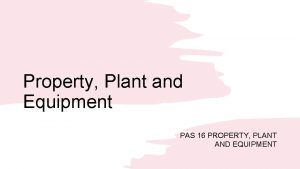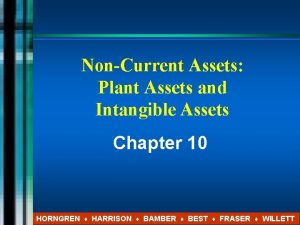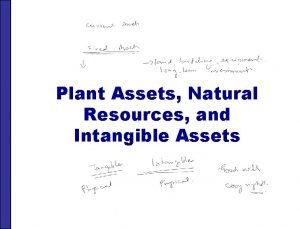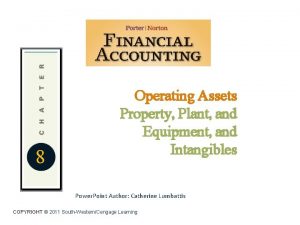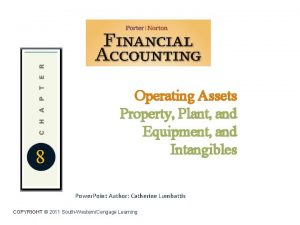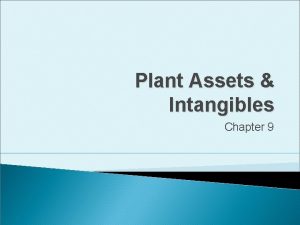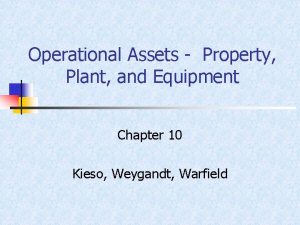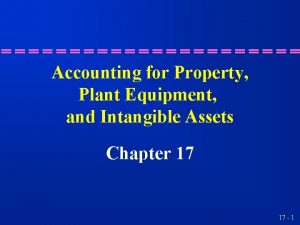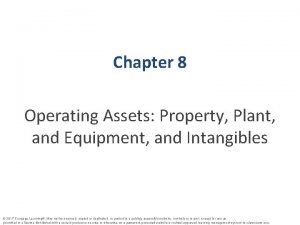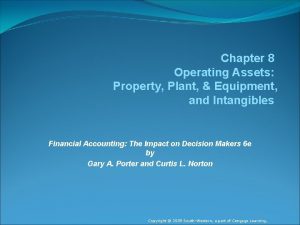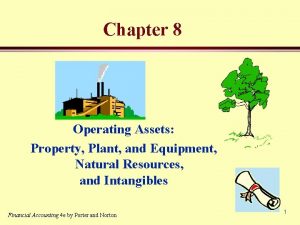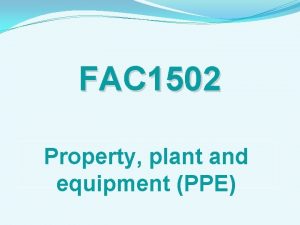Long Term Assets Property Plant and Equipment 1






















- Slides: 22

Long Term Assets Property, Plant and Equipment 1. TYPES 2. COST 3. DEPRECIATION 4. DISPOSAL

Characteristics Plant assets are tangible assets used in a company's operations that have a useful life of more than one accounting period. Plant assets are also called fixed assets. For many companies, plant assets make up the single largest class of assets they own. Plant assets are set apart from other assets by two important features. � First, plant assets are used in operations. This makes them different from, for instance, inventory that is held for sale and not used in operations. The distinctive feature here is use, not type of asset. A company that purchases a computer to resell it reports it on the balance sheet as inventory. If the same company purchases this computer to use in operations; it is a plant asset. � The second important feature is that plant assets have useful lives extending over more than one accounting period. This makes plant assets long term and not a current asset such as supplies that are normally consumed in a short time period after they are placed in use. The accounting for plant assets reflects these two features. Since plant assets are used in operations, companies match their costs against the revenues they generate in a systematic and rational manner by depreciating the asset called depreciation. Also, since their useful lives extend over more than one period, our matching of costs and revenues must extend over several periods. Depreciation expense XX Accumulated depreciation XX Land An important exception is land; land cost is not allocated to expense. Land is expected to have an indefinite life.

Asset Types �Land Improvements �Buildings �Machinery and Equipment

Important Concepts There are three major issues in accounting for plant assets: (1) computing the costs of plant assets (2) allocating the costs of most plant assets (less any salvage amounts) against revenues for the periods they benefit—depreciation (3) recording the disposal of plant assets.

Computing Costs Plant assets are recorded at cost when acquired in accordance with the historical cost principle. Cost includes all normal and reasonable expenditures necessary to get the asset in place and ready for its intended use. The cost of a machine, for instance, includes its invoice cost plus any required freight, unpacking, assembling, installing, and testing costs. Examples are the costs of building a base or foundation for a machine, providing electrical hookups, etc. To be recorded as part of the cost of a plant asset--an expenditure must be normal, reasonable, and necessary in preparing it for its intended use. Focus on this when trying to determine what costs should be added to an asset. If an asset is damaged during installation, the repairs are not added to its cost. The repairs are charged to expense. Paying a fine for moving heavy machinery without a proper permit is not part of the machinery's cost, but payment for a proper permit is included in the cost of machinery. Charges are sometimes incurred to modify or customize a new plant asset. These charges are added to the asset's cost.

Land When land is purchased for a building site, its cost includes the � total amount paid for the land, including any real estate commissions, title insurance fees, legal fees � any accrued property taxes paid by the purchaser � payments for surveying, clearing, grading, and draining � government assessments, whether incurred at the time of purchase or later, for items such as public roadways, sewers, and sidewalks. These assessments are included because they permanently add to the land's value. Land purchased as a building site for a future building sometimes includes structures that must be removed. Add the cost of removal and subtract any salvage proceeds. � A company pays $180, 000 cash to acquire land for a retail store. � This land had an old structure that was removed at a cost of $10, 000 � The company obtains salvage proceeds of $3, 000 from selling components of the old structure � Closing costs total $9, 800

Land Improvements Land has an indefinite life and is not used up over time. However, Land improvements have a limited life. Land improvements include such items as parking lot surfaces, driveways, fences, shrubs, lighting systems The costs of these improvements increase the usefulness of the land, but they are recorded in the general ledger in a separate Land Improvement account so that their costs can be depreciated in accordance with the future periods they benefit. This expense is “matched” to the revenues earned during these periods as the assets were put in place to help the company earn revenue.

Buildings A Building account is charged for the costs of purchasing or constructing a building that is used in operations. When purchased, a building's costs usually include all the necessary and reasonable costs to procure the building. � purchase price, � brokerage fees, � title fees � attorney fees � all expenditures to ready it for its intended use, including any necessary repairs or renovations such as wiring, lighting, flooring

Machinery and Equipment The costs of machinery and equipment consist of all costs normal and necessary to purchase them and prepare them for their intended use. These include the �purchase price, �tariffs �transportation charges, �insurance while in transit �installing, assembling, and testing of the machinery and equipment.

Lump Sum Purchase Plant assets sometimes are purchased as a group in a single transaction for a lump-sum price. The land, structure and land improvements already exist and are purchased together but need to be separately recorded in the general ledger for purposes of depreciation and to provide useful information on the financial statements. In order to allocate the asset values in the general ledger when there is a single price, we follow these steps Obtain the appraised tax value or market value of each type of asset Add these values together Calculate the percent of each asset class as portion of the total from Step 2 Multiple the single price by these percentages Determine the apportioned cost to be recorded in the general ledger.

DEPRECIATION Depreciation is the process of systematically and rationally allocating the cost of a plant asset to expense in the accounting periods benefiting from its use. The assets were placed into service in order to help the company generate revenue and their costs must be matched to the revenue they helped to generate. Depreciation does not measure the decline in the asset's market value each period, nor does it measure the asset's physical deterioration. Factors in Computing Depreciation Factors that determine depreciation are (1) cost, (2) salvage value, and (3) useful life. NOTE: Salvage value and useful life are estimates. Salvage value is an estimate of the asset's value at the end of its benefit period. Useful Life is the length of time it is productively used in a company's operations. For example, the productive life of a computer can be eight years or more. Some companies, however, trade in old computers for new ones every two years. In this case, these computers have a two-year useful life.

Depreciation Methods Depreciation methods are used to allocate a plant asset's cost over the accounting periods in its useful life. � Straight Line Method The most frequently used method � Units of Production Method – Method when assets are infrequently in use. � Double Declining Balance – Method used for tax purposes. We will use the following example to understand how to calculate depreciation for these three methods

Straight-Line Method Straight-line depreciation charges the same amount of expense to each period of the asset's useful life. Example 1. If the machine was placed in service on Jan 1 and we are preparing financial statements as of Dec 31, then … 1. Determine depreciable base Example 2. If the machine was placed in service on Jul 1 and we are preparing financial statements as of Dec 31, then … 2. Divide the depreciable base by number of months in the useful life and multiply this product by the number of months associated with the accounting period. The $1, 800 Depreciation Expense is reported on the income statement among operating expenses. The $1, 800 Accumulated Depreciation is a contra asset account to the Machinery account in the balance sheet.

Net Book Value � Very important concept: The net balance sheet amount is the asset book value, or simply book value, and is computed as the asset's total cost less its accumulated depreciation. Do not confuse the calculation of book value with depreciable base— they do look similar

Continued Example of Book Value �At the end of year two, the book value is $6, 400 and is reported in the balance sheet as follows: � The book value of this machine declines by $1, 800 each year due to depreciation. Important to know the concept of book value and accumulated depreciation when we calculate the gain or loss on the disposal of property, plant and equipment. � Note: Ending book value is the salvage value.

Units-of-Production Method � The use of some plant assets varies greatly from one period to the next based upon usage of a machine. It may be idle for a portion of the year. A builder, for instance, might use a piece of construction equipment for a month and then not use it again for several months. When equipment use varies from period to period, the units-of-production depreciation method can better match expenses with revenues. � Units-of-production depreciation charges a varying amount to expense for each period of an asset's useful life depending on its usage.

Units of Production Book Value Note: Ending book value is the salvage value.

Declining-Balance Method An accelerated depreciation method yields larger depreciation expenses in the early years of an asset's life and less depreciation in later years. Chosen for tax purposes � The rate is calculated as 100% divided by the useful life in years. This result is multiplied by 2 to obtain the double declining balance rate. � The rate is then applied to book value for each year. In the first year, the book value equals the asset cost because accumulated depreciation is not yet recorded.

Change in Estimates for Depreciation is based on estimates of salvage value and useful life. During the useful life of an asset, these estimates can change. Use the new estimate to compute depreciation for current and future periods. An Example. At the beginning of an asset's third year, its book value is $6, 400, computed as $10, 000 minus $3, 600. Assume that at the beginning of its third year (or end of second year), the estimated number of years remaining in its useful life changes from three to four years and its estimate of salvage value changes from $1, 000 to $400. Straight-line depreciation for each of the four remaining years is computed as: Revising an estimate of the useful life or salvage value of a plant asset is referred to as a change in an accounting estimate and is reflected in current and future financial statements, not in prior statements.

Reporting Accumulated Depreciation � Both the cost and accumulated depreciation of plant assets are reported on the balance sheet or in its notes. Reporting both the cost and accumulated depreciation of plant assets helps users compare the assets of different companies. � For example, a company holding assets costing $50, 000 and accumulated depreciation of $40, 000 is likely in a situation different from a company with new assets costing $10, 000. While the book value of $10, 000 is the same in both cases, the first company is facing the need to replace older assets. These insights are not provided if the two balance sheets report only the $10, 000 book values.

Disposal of Plant Assets Disposals of plant assets occur in one of three basic ways: discarding, sale, or exchange. We will cover discarding and sales. Asset Discarding - Journal entry steps. � Credit the asset based on the general ledger amount. � Debit the accumulated depreciation based on the general ledger amount. � If the asset is not fully depreciated, record Loss on Disposal of Asset for the difference. NOTE: There can only be a loss when an asset is discarded. Fully Depreciated Example: A machine costing $9, 000 with accumulated depreciation of $9, 000 is discarded. When accumulated depreciation equals the asset's cost, it is said to be fully depreciated (zero book value). The entry to record the discarding of this asset is Not Fully Depreciated Example: How do we account for discarding an asset that is not fully depreciated or one whose depreciation is not up-todate? Bring depreciation up-to-date. Ex: Asset has a cost of $9, 000 and accumulated depreciation of $6, 500 NOTE: There can only be a loss when an asset is discarded and only if it is not fully depreciated.

Sale of Plant Asset – Sales of plant assets can yield gain or losses. Journal entry steps. � Credit the asset based on the general ledger amount. � Debit the accumulated depreciation based on the general ledger amount. � Record the cash received. � If there is a difference, either debit Loss on Asset Disposal or credit Gain on Asset Disposal. Make sure to bring depreciation up to date if necessary Sale at Book Value Note: Book value is cost minus accumulated depreciation. Sale above book value Sale below book value
 Property, plant, and equipment and intangible assets are
Property, plant, and equipment and intangible assets are Fixed assets property plant equipment
Fixed assets property plant equipment Plant assets are
Plant assets are Accumulated depreciation straight line method
Accumulated depreciation straight line method Plant assets, natural resources, and intangible assets
Plant assets, natural resources, and intangible assets Depreciation of equipment
Depreciation of equipment Acquisition and disposition of property plant and equipment
Acquisition and disposition of property plant and equipment Acquisition and disposition of property plant and equipment
Acquisition and disposition of property plant and equipment Acquisition and disposition of property plant and equipment
Acquisition and disposition of property plant and equipment Lkas 16 presentation in sinhala medium
Lkas 16 presentation in sinhala medium Ppe
Ppe Plant assets are used in operations
Plant assets are used in operations Fixed asset note grade 11
Fixed asset note grade 11 Valuation of property plant and equipment
Valuation of property plant and equipment Intermediate accounting chapter 10
Intermediate accounting chapter 10 Ind as 16 property plant and equipment
Ind as 16 property plant and equipment Other long term assets
Other long term assets Other long term assets
Other long term assets Other long term assets
Other long term assets What is intangible assets in balance sheet
What is intangible assets in balance sheet Long term operational assets
Long term operational assets Types of real assets
Types of real assets Financial assets and real assets
Financial assets and real assets
